Whatever animal you see grabbing & swallowing their food may give you goosebumps when you were little. An axolotl does the same which may look a bit ‘’ shark-like‘’ but there’s a ton of difference in reality.
Axolotls have teeth that work mainly for grabbing their food. And they can’t use their teeth to chew or crush any food object.
Whenever an axolotl will bite you mistakenly, you won’t have any serious injury, not even minor bleeding most of the time. Just follow the basic procedure like washing hands with anti-bacterial liquid & applying a band-aid.
In this article you will explore whether axolotl bite hurt too much or are okay to deal with regularly. On top of that, you will also know about the preventive measures to keep your axolotl safe.
Does axolotl bite hurt too much?
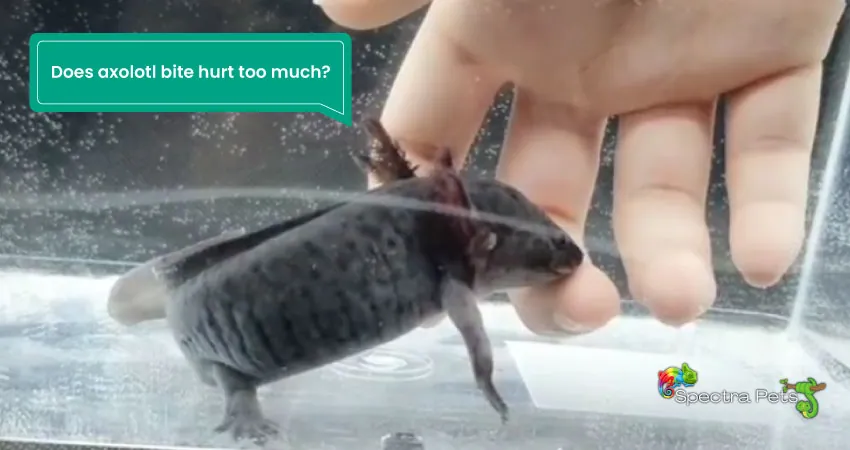
Beginner axolotl owners might get shocked when they get a bite from a beautiful pet. But in reality, it’s just the shock but there would be no pain. Right after having some bite, you will realize these are nothing.
Whenever an axolotl will bite you it won’t even be able to puncture the skin and there won’t be any bleeding due to that. So the bite won’t lead to any pain either. The closest feeling of their bite resembles a slight rubbing of sandpaper or velcro. From this example, you can guess how light the bite will be on your hand.
Read Next: Are Axolotls Good Pets For Beginners?
Why do axolotls bite?

By nature, axolotls are not very aggressive animals but they have hunting instincts that help them to keep on feeding. Mainly there are 2 common reasons found behind their biting characteristics. For feeding & defending.
These gentle creatures have a built-in sensor which makes them consider moving objects as their food. Which is the reason many axolotl owners might find themselves bitten by their pets during feeding. They often consider the finger as a potential food due to the movement. This ends up giving a bite to their caretaker.
Another reason axolotl can bite is when they feel threatened & try to defend themselves. Though their common behavior is to run away from potential threats this can happen once in a while.
How to handle axolotls?
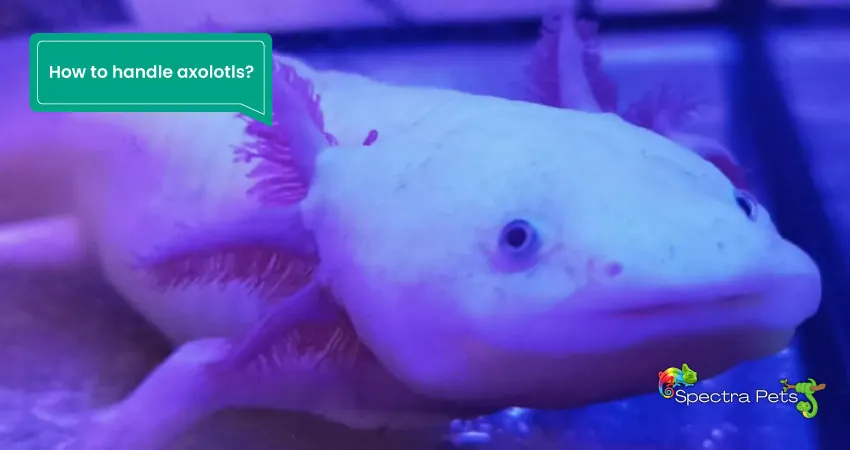
Unlike other home pets, axolotls are sensitive amphibians that need to be handled carefully. It won’t be a good idea to treat & handle them like a fish. No matter how gently you handle them there’s always a chance of your axolotl getting injured. Slight touching is okay during cleaning the tank.
During feeding time if you want to make a bond you can give them a little tap. But keep the touching as minimum as possible. These fragile amphibians can easily lose their limbs if you handle them in a bit of careless manner. Though it can grow back the limbs, life risk lies there.
Moreover, the absence of any protective layer on the skin makes them extremely vulnerable. On top of that, the ultra-thin make them exceptionally weak creatures that can get infected easily.
So 3 simple rules you must remember while handling an axolotl: don’t hold them long, try to touch them softly & less, and wash your hands before touching the axolotl to prevent any infection.
What to do if axolotls bite your hand?
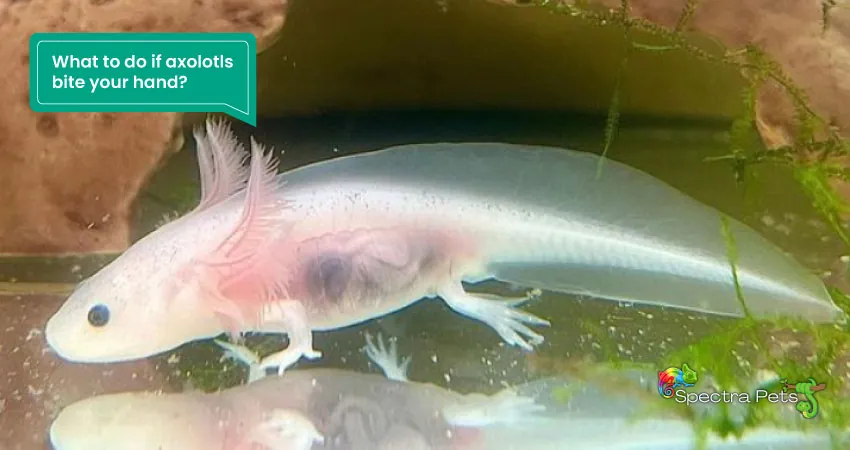
On a happy morning, while feeding your axolotl if you accidentally get a bite from them just stay relaxed. Because these creatures won’t be able to bleed you through a bite. While they hold on to biting, never try to push it off with force because it would turn deadly as it can damage their teeth which would make it hard to grab their food.
Even if in the rare case you can bleed a bit after the bite then simply wash the spot with a high-quality antibacterial solution and then apply a bandage.
In addition to that, you should have a close monitor of the axolotl after the biting incident. Because your axolotl is the one to become more injured than you. Check if they can properly eat their food.
As a part of caution, if you are a parent, don’t allow your toddler or little kids to feed the axolotl. Because children’s skin is soft & they will get hurt more than any adult.
If your axolotl bites your little kid, they will surely try to get their hands off out of fear, which can hurt your axolotl badly.
How to stop your axolotl from biting your hand?
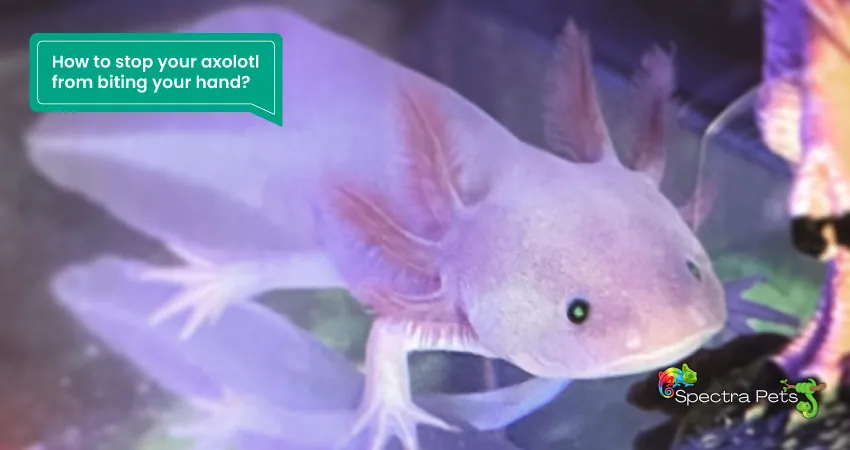
If you find your axolotl way too friendly with you and frequently biting your finger thinking of it as food, then you can help yourself & the pet by using a simple method.
Axolotls are one of those amphibians that lead a solitary life, so they won’t mind if you don’t; feed them with your hand. You can feed them using forceps. Plus, you can also use a turkey baster for feeding your beautiful pet.
Both of these tools are made to hold the food perfectly. So feed them without getting a single bite using this stuff.
Do axolotls carry salmonella?
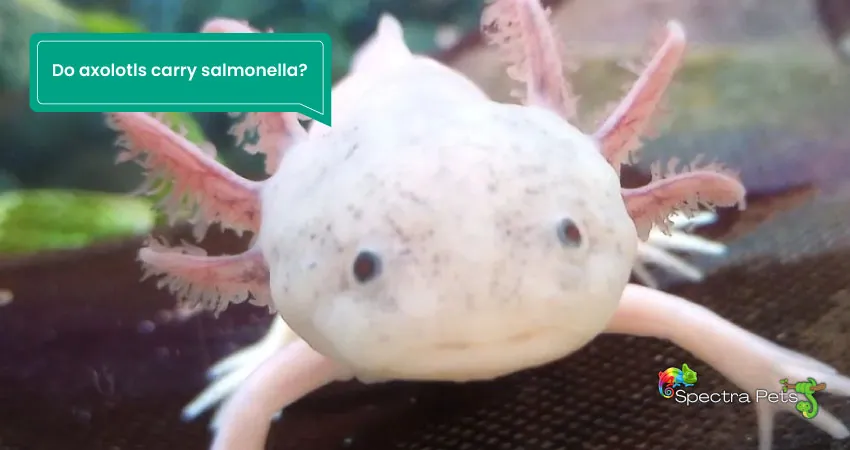
Being no different from most amphibians, axolotl does carry salmonella. And to get rid of them from your axolotl body is literally impossible. Salmonella makes its way to the digestive tract of anxiety & does no physical harm to your pet.
But once it gets transferred from the axolotl to the human body, it can cause issues like diarrhea & vomiting, etc. So the risk of getting salmonella from your axolotl is always there as long as they live with you.
Salmonella is a bit dangerous for small kids, and pregnant mothers, so you have to stay very alert about the kid touching the axolotl. Even if your kids touch them, you must ensure they are washed before and after with the antibacterial solution.
Why do axolotls bite their tank mates?
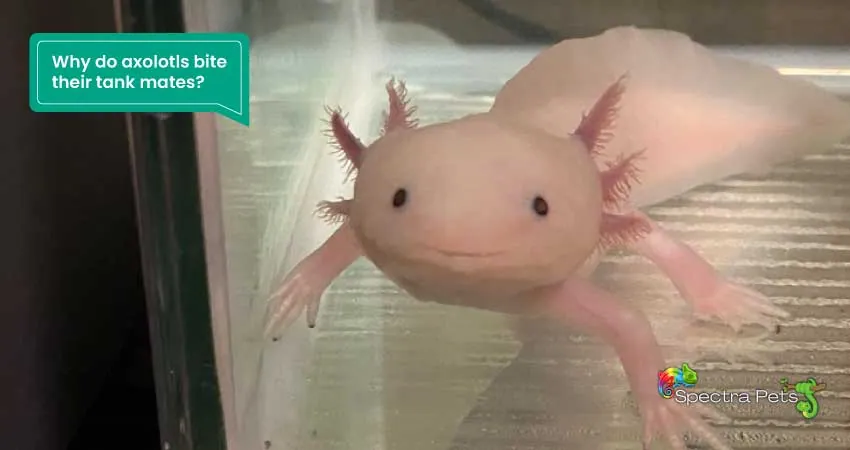
When axolotls start biting their tank partner, that can indicate 2 things. One is that they want to eat the other tank mates who are smaller than them in size, so they consider them as food and keep biting. That’s why it’s not recommended to keep a big & small axolotl inside the same tank. If you keep 2 axolotls, it has to be the same size.
Sometimes Axolotl’s territorial mood turns a bit serious, and they simply chase the other tank mates who come to explore their living area inside the tank.
Frequently asked questions (FAQ)
Does axolotl have teeth?
Yes, this cute little fella has teeth but luckily these teeth are very soft. The texture of the teeth is similar to rubber. Their teeth are tailored for holding their food so that they can swallow easily. However, axolotls can’t chew, crush, or rip through their food using their teeth.
Are axolotls friendly to humans?
Their nature is solitary, so they don’t have that friendly nature. But if you feed them regularly, they might get familiar with your hand. So they won’t feel stressed and remain calm & friendly.
Will my axolotl bite me?
Yes, your lovely axolotl can bite you thinking your finger is their food.
Are axolotl bites poisonous?
Axolotl bites are not poisonous at all. Rather, they might get an infection from you if you touch them without washing your hands properly.
What does an axolotl bite feel like?
An axolotl bite will feel as if someone is rubbing your finger with sandpaper or Velcro slightly.
Are axolotls safe to handle?
Yes, it is safe to handle axolotls as long as you can do it without hurting them. Any wrong handling would make them injured.
Can axolotls hurt you?
No axolotl won’t hurt you because their teeth are soft and won’t bleed your hand at all. So you don’t need to worry about getting hurt from the bite of the axolotl.
Final words
Hopefully from this post you acquired an ample amount of information about whether an axolotl bite hurts.
Now you know how to handle your axolotl and how to deal with it when they bite you. If you have kids at home, do share the basic info with them to keep both your axolotl & child safe.

